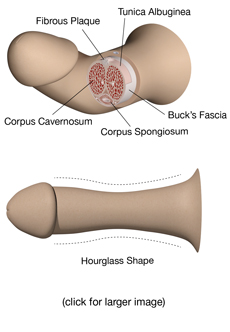Symptoms

Since Peyronie's disease is a wound healing disorder, there are constant changes that take place at the onset of the condition. These changes are classified into two categories:
- The acute inflammatory phase which occurs during the first six to eighteen months in which pain is common.
- The chronic or stable phase where the symptoms reach their most severe state.
The plaque forms in a part of the penis called the tunica albuginia and can usually be felt just under the skin in the shaft of the penis. The plaque reduces the elasticity of the tunica albuginia, which can result in symptoms such as penile curvature, painful erections, constrictions or indentations along the shaft, loss of length and/or girth, and erectile dysfunction. In addition to the physical symptoms, Peyronie's disease can also have a significant emotional impact on patients. A questionnaire used in a study of Peyronie's disease patients found that 77% suffered from psychological effects of the condition and 65% of those patients stated that the problem concerned them frequently*.